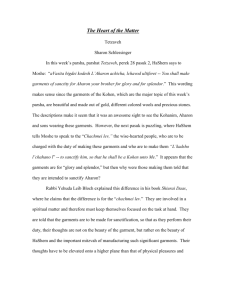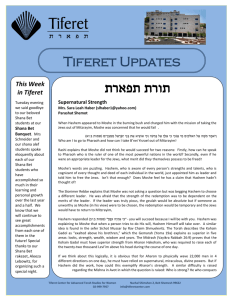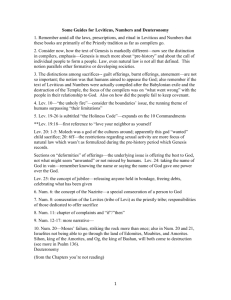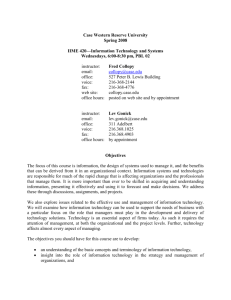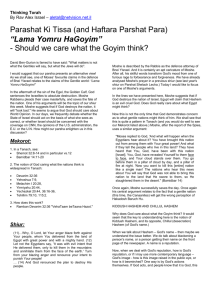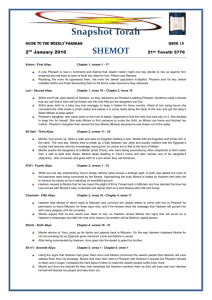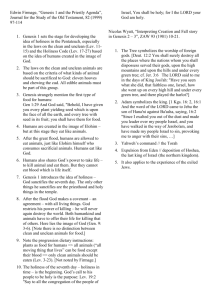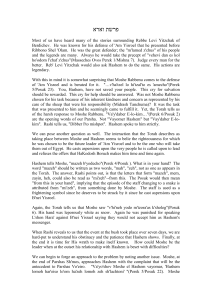שבת ויקהל\פקודי פרשת פרה There are a number of surprises for us
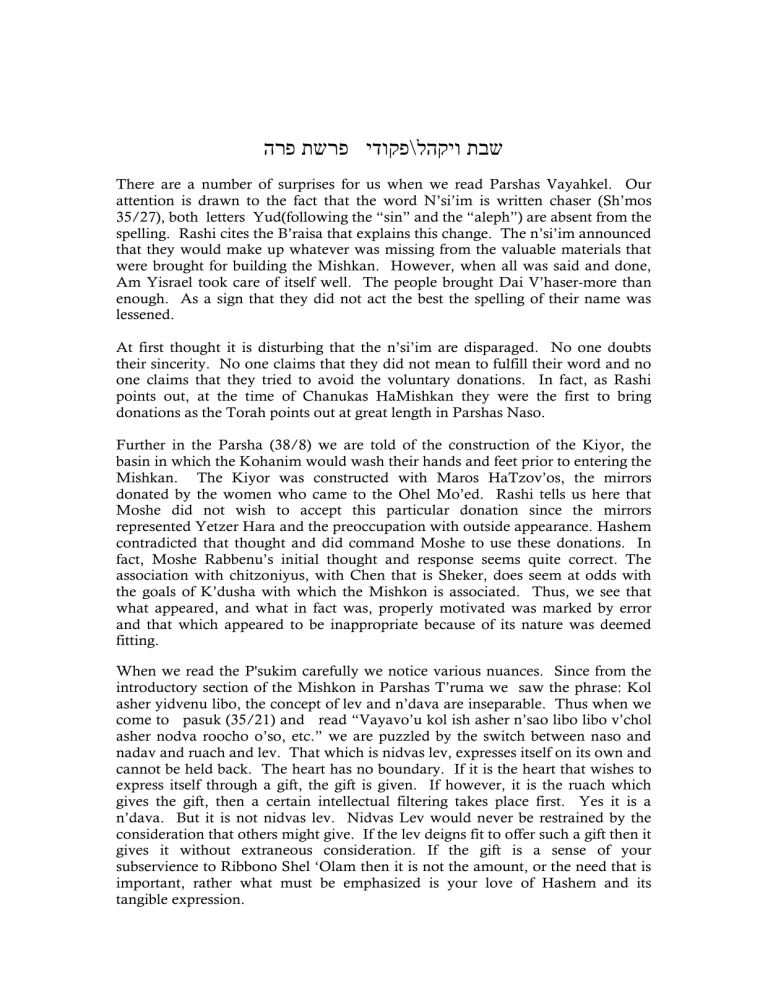
הרפ תשרפ ידוקפ \ להקיו תבש
There are a number of surprises for us when we read Parshas Vayahkel. Our attention is drawn to the fact that the word N’si’im is written chaser (Sh’mos
35/27), both letters Yud(following the “sin” and the “aleph”) are absent from the spelling. Rashi cites the B’raisa that explains this change. The n’si’im announced that they would make up whatever was missing from the valuable materials that were brought for building the Mishkan. However, when all was said and done,
Am Yisrael took care of itself well. The people brought Dai V’haser-more than enough. As a sign that they did not act the best the spelling of their name was lessened.
At first thought it is disturbing that the n’si’im are disparaged. No one doubts their sincerity. No one claims that they did not mean to fulfill their word and no one claims that they tried to avoid the voluntary donations. In fact, as Rashi points out, at the time of Chanukas HaMishkan they were the first to bring donations as the Torah points out at great length in Parshas Naso.
Further in the Parsha (38/8) we are told of the construction of the Kiyor, the basin in which the Kohanim would wash their hands and feet prior to entering the
Mishkan. The Kiyor was constructed with Maros HaTzov’os, the mirrors donated by the women who came to the Ohel Mo’ed. Rashi tells us here that
Moshe did not wish to accept this particular donation since the mirrors represented Yetzer Hara and the preoccupation with outside appearance. Hashem contradicted that thought and did command Moshe to use these donations. In fact, Moshe Rabbenu’s initial thought and response seems quite correct. The association with chitzoniyus, with Chen that is Sheker, does seem at odds with the goals of K’dusha with which the Mishkon is associated. Thus, we see that what appeared, and what in fact was, properly motivated was marked by error and that which appeared to be inappropriate because of its nature was deemed fitting.
When we read the P'sukim carefully we notice various nuances. Since from the introductory section of the Mishkon in Parshas T’ruma we saw the phrase: Kol asher yidvenu libo, the concept of lev and n’dava are inseparable. Thus when we come to pasuk (35/21) and read “Vayavo’u kol ish asher n’sao libo libo v’chol asher nodva roocho o’so, etc.” we are puzzled by the switch between naso and nadav and ruach and lev. That which is nidvas lev, expresses itself on its own and cannot be held back. The heart has no boundary. If it is the heart that wishes to express itself through a gift, the gift is given. If however, it is the ruach which gives the gift, then a certain intellectual filtering takes place first. Yes it is a n’dava. But it is not nidvas lev. Nidvas Lev would never be restrained by the consideration that others might give. If the lev deigns fit to offer such a gift then it gives it without extraneous consideration. If the gift is a sense of your subservience to Ribbono Shel ‘Olam then it is not the amount, or the need that is important, rather what must be emphasized is your love of Hashem and its tangible expression.
If however it is not nidvas lev, but n’si’as lev, then there is a different approach altogether. The heart senses its own importance. It is raised and it is the ruach that donates but not the heart. The donation of the ruach only comes about after an intellectual consideration; it does not have the purity of nidvas lev.
Thus the above Posuk that tells us that there were some who did not reach the standard of yidvenu libo, they fell short and only reached nidvas haruach because they were stricken with n’si’as halev.
In Posuk 29, however, the familiar refrain of nadav libam reappears. What is the difference between these two P'sukim? It is very noticeable that the first Posuk, wherein the gifts were not fully appropriate, did not reach nidvas lev, mentions the word “ish”, alone. The second Posuk says ish v’isha, man and woman.
It is possible that Posuk 21 is referring to the n’si’im and we have a foreshadowing of their incomplete inner motivation whereas Posuk 29 that again mentions nidvas lev talks about ish v’isha, man and woman.
And here we have the resolution of the paradox. Ribbono Shel Olam is bochen klayos v’lev. He knows what is going on and He removed the Yud from the word n’si’im. He removed the Yud since they were missing their Yud, their pinteleh
Yid, their n’shama which could not, or would not give expression to the devotion and dedication of the heart. The women however, not unlike many of their male counterparts gave from the heart. They had kavana r’tzuya and thus Moshe was told their motivation was to change the yetzer hara to a kli hamishkan and add to its holiness.
This concept that not everything is the way it seems, that one needs to see the inner workings, is found in the beginning of P’kudei as well. What does “asher pakad Moshe” refer to, asks Chasam Sofer. He explains the usage of the term according to the Gemara in Bava Metzia 42 a. There we are told something perplexing. That which is measure, quantified, will not have a b’racha. Thus when one measures his grain production he must say a special t’fila, Y’hi Ratzon,
May it be Hashem’s well to bless this grain. His act of measurement has harmed the inherent b’racha and the farmer must turn to Hashem to request another.
Explains Chasam Sofer such is the case in P’kudei. Moshe must enumerate all of the donations and gifts. He must say their precise number and weight. Will the
Mishkan not have a b’racha because of this necessary accounting? Moshe thus turns to Hashem with a pkida. He calls Hashem to remember Am Yisrael and to bless them in order that the generosity of Hashem not be lessened during the season of measuring. (Chasam Sofer mentions that this thought is found similarly in the Zohar).
It might seem that the number itself is the blessing. It might seem that by knowing that you have a large amount you will recognize the blessing. On the contrary say
Chazal. When you know the measure of your accomplishment, you might fall prey to the misunderstanding and say you don’t need Hashem’s brachoh, you have plenty already.
That things are not necessarily what they seem to be is also found in our special
Maftir. Tum’a and Tahara are not visible nor are they easily understood, neither in their deeper meaning not in their hashkafa. One thing, however, is true. If it is to bring Tum’a then it certainly should be based in Tum’a. If it brings Tahara, it should be based on Tahara. Comes Parah Aduma and says that things are not what they seem to be. The Kohen who sprinkles you with the water of the Mei
Chatas becomes tamei as you are changed into purity.
Only Hashem who sees deeply into us can decide Tuma and Tahara. Only He can decide if our kavanos are acceptable or not. For only He knows the difference between the real me and all of the outside accoutrements that I adopt.
Shabbat Shalom
Rabbi Pollock

